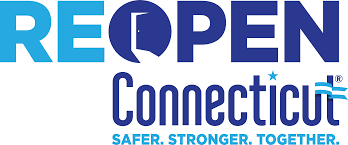June 18th Updates: Indoor & Outdoor Events, Public Transportation

To help you and our neighbors stay up-to-date on the ever-evolving stream of information related to the COVID-19 pandemic, my office and I are working to provide news as it develops over social media and by email. This is a recap of some of this week’s highlights.
Below you can find information on the following topics:
- Indoor & Outdoor Gatherings
- Guidelines & Information on Traveling in Connecticut
- Changes to the Paycheck Protection Program
- Executive Order on Police Accountability & Modernization
For more information about the state's response efforts visit ct.gov/coronavirus. To receive text message notifications, sign up for CTAlert, the state’s emergency alert system. To subscribe, text "COVIDCT" to 888-777.
Indoor & Outdoor Gatherings
On Tuesday, Governor Lamont announced updated guidance for indoor and outdoor gatherings over the next several weeks.
The plan is as follows:
Effective June 17:
- Indoor private gatherings – 25 people
- Outdoor gatherings – 100 people
- Outdoor event venues (e.g. amphitheaters, race tracks) – 25% of fire capacity and distancing (consistent with outdoor amusement parks)
Effective July 3:
- Indoor private gatherings – 25 people
- Outdoor private gatherings – 100 people, one time exception for graduations at 150 people
- Outdoor organized gatherings (e.g. fireworks, concerts in municipal parks) – 15 feet of space blanket to blanket, cap of 500 people; event organizer responsible for compliance with guidance
- Outdoor event venues (e.g. amphitheaters, race tracks) – 25% of fire capacity and distancing
Effective mid-July (date to be determined):
- Indoor private gatherings – 50 people
- Outdoor private gatherings (including graduations) – 250 people
- Outdoor organized gatherings (e.g. fireworks, concerts in municipal parks) – 15 feet of space blanket to blanket, no cap; event organizer responsible for compliance with guidance
- Outdoor event venues (e.g. amphitheaters, race tracks) – 50% of fire capacity and distancing
Guidelines & Information on Traveling in Connecticut
As Connecticut enters Phase 2 of reopening, the Department of Transportation (DOT) has released new information on what state residents can expect for train, bus, and highway travel.
Trains
Earlier this week, Metro-North Railroad announced it has begun to increase train service on the New Haven Line. The new schedule will provide a 115% increase, with several trains added in the morning and afternoon peak periods. Metro-North will continue to fully disinfect stations every 12 hours and trains every 24 hours.
In addition, customers and employees are required to wear a mask or face covering at all times while in stations, on platforms, onboard trains, and at the Terminal.
Rail service on the Hartford Line and Shore Line East continues to operate on a limited schedule. Danbury Line and Waterbury Line service remains suspended to accelerate ongoing capital projects.
Buses
According to the DOT's release:
"On the bus system, riders will continue to board through the rear door on buses so equipped. Some buses already feature clear plastic dividers between the bus driver and the general public and CTtransit is moving forward with the procurement and installation of additional driver barriers on other buses. These barriers are expected to be installed before Labor Day 2020."
Highways
The DOT also announced that the 23 service plazas on I-95, Route 15 and I-395 (as well as the seven rest areas along I-95, I-91, and I-84) are fully open for food, fuel, restrooms and other amenities. All services plazas and rest areas have implemented enhanced and more frequent cleaning in common areas.
Changes to the Paycheck Protection Program
I want to be sure to inform you of the changes Congress recently made to the Paycheck Protection Program (PPP), which was created in March in an effort to help small businesses affected by the COVID-19 pandemic.
The Paycheck Protection Flexibility Act, which was signed into law on June 5th, eases some of the restrictions on how businesses use and pay back the loans they receive from the Paycheck Protections Program.
According to a release from David Lehman, the head of the Connecticut Department of Economic and Community Development (DECD), key changes to the PPP include the following:
- Extends the period to use PPP funds from 8 weeks to 24 weeks
- Reduces from 75% to 60% the amount a company must spend on payroll
- Borrowers may now use the 24-week period to fully restore their workforce levels and wages (December 31 instead of June 30)
- Businesses now have five years to repay the loan, instead of two
If you or someone you know owns a small business and would like more information on these recent changes to the Paycheck Protection Program, click here.
Governor Lamont Issues Executive Order on Police Accountability, Modernization
In response to the horrible murder in Minneapolis of George Floyd by police officers and the ongoing national discussion of police reform, Governor Lamont signed an executive order on Monday that makes several changes to how the Connecticut State Police operates.
According to Governor Lamont's Office, the new order implements the following changes:
- Bans the Connecticut State Police from using chokeholds, strangleholds, arm-bar control holds, lateral vascular neck restraints, carotid restraints, chest compressions, or any other tactics that restrict oxygen or blood flow to the head or neck.
- Requires the Department of Emergency Services and Public Protection (DESPP) to review the Connecticut State Police Administrative and Operations Manual and update it to include the following requirements and prohibitions:
- Require troopers to de-escalate situations, when possible, before using force;
- Require troopers to provide a verbal warning, when possible, before using deadly force;
- Require troopers to exhaust all other reasonable alternatives before resorting to deadly force;
- Require troopers to intervene to stop another law enforcement officer from using excessive force, and to report any such use to a supervisor in writing;
- Prohibit troopers from shooting at or into moving vehicles unless the occupants of the vehicle pose a deadly threat by means other than the vehicle;
- Include a use-of-force matrix; and
- Require troopers to report all uses of force, including drawing a firearm on another civilian.
- Requires DESPP to appoint and train community trust liaisons in each Connecticut State Police Troop and instruct them to assist those troops in building relationships with residents and community-based organizations, learning from those residents and organizations about how to better serve their communities, and making it easier for those residents and organizations to communicate with the State Police.
- Prohibits DESPP from purchasing or otherwise acquiring military and military-style equipment from the federal government until further notice.
- Directs every uniformed officer of the Connecticut State Police to be equipped with a body camera and every marked vehicle of the Connecticut State Police to be equipped with a dashboard camera.





